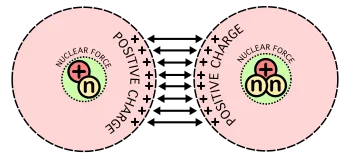Today I'd like to share a topic I've been fascinated with for awhile: Fusing atoms using a pyroelectric crystal. This concept is only about a decade old, and shows that not all nuclear fusion has to be done in billion dollar massive research facilities.
Pyroelectric fusion doesn't require dangerous high voltages, large plasma chambers, confinement fields, or expensive facilities. While it is still not easy to set up, a pyroelectric fusion device requires a vacuum chamber, gas feed system, and one very special crystal.
As usual, I'd like to go into some background before getting to the main subject. If you already know the basics of nuclear fusion, you can skip ahead to the relevant title block.
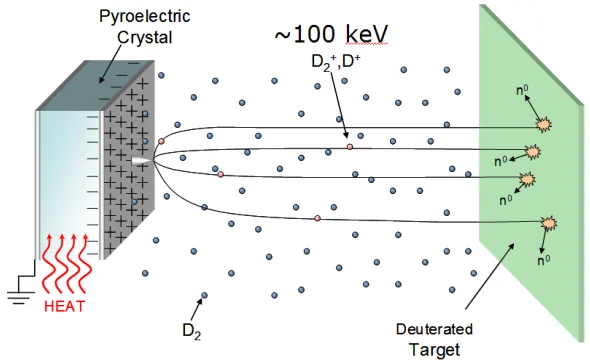
A good summary image for Pyroelectric Fusion.
Credit
The Basics of Nuclear Fusion
All atoms contain a heavy nucleus made up of protons and neutrons. Strip an atom of all its electrons and you are left with a bare nucleus, made positive by its numerous protons. All nuclei are positively charged, so all bare nuclei will repel each other via the electromagnetic force. If you try to bring two nuclei together, they will be thrown apart by the strong electrostatic repulsion brought about by the charges in the protons.
But electromagnetism is only one of four fundamental forces. Another force, the Strong interaction, comes into play. The strong force is negligible at macroscopic distances, but at very tiny subatomic length scales it can easily overpower the electromagnetic force. Bring two nuclei close enough together for the strong force to take hold, and they will fuse together, producing whatever fusion products result from such a reaction (often this can involve the new fused atom breaking up into decay products).
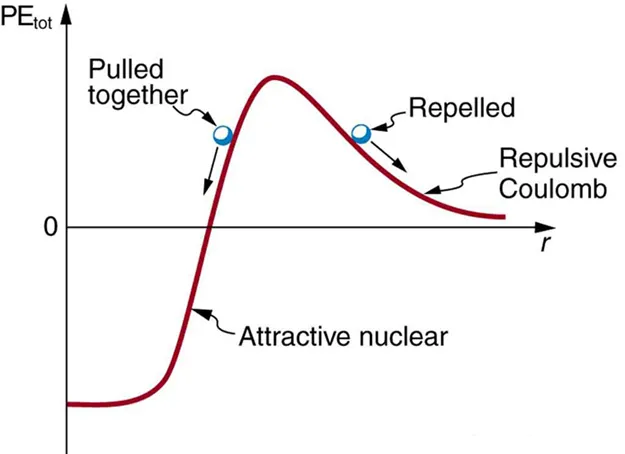
This is a basic nuclear fusion potential energy plot. If you give your nucleus enough energy to crest the hill, it will fall into the strong-force valley and fuse with the other nucleus
Credit
But the kinetic energy required to get past the electromagnetic force into the realm of the strong force is huge. This energy is so huge that the core of the sun itself shouldn't be fusing any hydrogen, since the temperature is not hot enough for significant amounts of protons to break through the electromagnetic barrier and fuse.
Quantum tunneling saves us from a cold, dark, sunless existence. As two nuclei get closer together, the probability of one of the nuclei tunneling past the large electromagnetic potential barrier and into the realm of the strong force also increases. For a very rough way to calculate this, see the Gamow factor. What this means is that, roughly speaking, nuclear fusion is probabilistic. And, to get two nuclei close together, you need to give them lots of kinetic energy so that they can push into the electromagnetic barrier when they hit each other.

Gamow Factor Formula
Credit
If you drop an ice cube into a cup of water, you are giving the hydrogen atoms in the ice lattice some additional kinetic energy. But this is not sufficient to do any fusion, of course, or dropping ice would cause city-destroying explosions. But by stripping atoms of their electrons and then firing them at other atoms by accelerating the nuclei in a strong electric field, we can induce artificial fusion reactions, and change two elements into a third different one: Alchemy that works!
Deuterium-Deuterium Fusion
D-D fusion as its called involves fusing two deuterium nuclei together. Deuterium is an uncommon isotope of hydrogen, containing one proton and one neutron per atom. It acts almost exactly like normal proton hydrogen does, with some slightly different properties brought about by the increase in mass. Unlike the next isotope up (Tritium), Deuterium is not radioactive and is stable, like regular hydrogen. Since it is stable, it can be found naturally, with one in every few thousand hydrogen nuclei found in nature being a deuterium nuclei.
If two deuterium ions (called deuterons) are brought together close enough, they can fuse. This process is exothermic, and as such, the nuclear fusion reaction liberates energy that had previously been in the mass of the two deuterons: The reaction produces more kinetic energy than was put in. This means that, in theory, you can generate excess power by fusing atoms found naturally in the ocean. Of course, nobody has yet done this in a way that actually produces more power out than in due to the complexity of the problem.
D-D fusion ordinarily produces one of two possible outcomes. In one result, the two deuterons turn into a triton (Tritium nucleus) and a proton, both carrying away a lot of kinetic energy. In a second result, the deuterons fuse to form a Helium-3 nucleus and a free neutron. A third, rare outcome exists in which the two fuse to form a single Helium-4 nucleus that then lets off a very high energy gamma ray. It is the second, neutron producing outcome that makes it easy to detect D-D fusion, as neutrons are not produced in many natural processes.

D-D fusion happens to be one of the easiest fusion reactions to achieve, energetically speaking, coming in after D-T (deuterium-tritium fusion). This makes it one of the fusion reactions most studied by researchers. And, it happens to be the reaction that was used in the first pyroelectric fusion experiment...
Pyroelectric Fusion
Certain crystal structures have the strange property that they will polarize when heated up or cooled down. What this means is that when a pyroelectric crystal changes temperature, opposite charges build up on the two sides of the crystal. This produces a voltage and electric field, and can accelerate charges or drive circuits. In fact, pyroelectric crystals are one of several ways to generate electricity using waste heat.
These crystals are used to build the common PIR motion detectors, which can detect a person based on the heat generated via infrared radiation from their body.
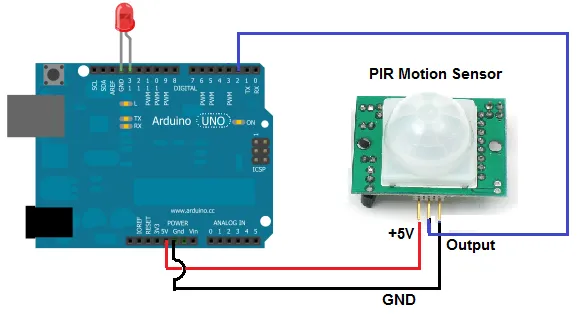
This beginner circuit uses a PIR detector to detect motion. Inside, tiny pyroelectric crystals detect temperature differences produced by thermal infrared light put off by people.
Credit
But the electric field produced by pyroelectric crystals can be very strong. In this case, it can be strong enough to accelerate ions to fusion energies.
The original pyroelectric nuclear fusion experiment was conducted at UCLA in 2004 and published in 2005. This experiment involved a Lithium Tantalate (LiTaO3) crystal placed into a vacuum chamber full of deuterium gas at pressures less than 1/100000 of those at sea level. A heater was placed on the back of the crystal. Since the deuterium gas in the chamber was extremely low pressure (to the point were it can safely be considered a somewhat decent vacuum for many purposes), the crystal is very well insulated and can only lose heat via thermal radiation and heat loss to the surrounding chamber. This makes it easy to heat up the crystal to higher temperatures.
When the crystal is heated up, its temperature changes and it polarizes, moving charges across the crystal. As these charges build up, the crystal becomes a sort of electric dipole, and the electric field surrounding the crystal increases. But deuterium gas atoms are neutral, and as such are not affected by the increasing E-fields. The deuterium atoms must first be ionized - stripped of their electron - to be accelerated.
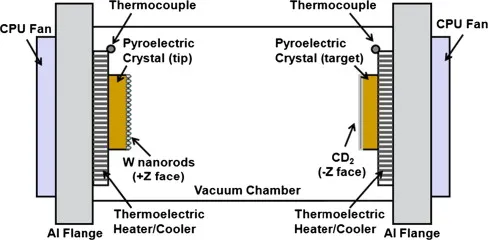
Schematic of Crystal Fusion Device
Credit
A tungsten metal needle was attached to the crystal. This has the effect of ionizing the gas. When a conductive piece of metal is attached to a voltage source (say, a battery) the entire metal suddenly has the same voltage. The mathematical consequence of this is that the space surrounding sharp points/edges on the metal will have an increased electric field. And, to ionize neutral gas atoms, you need a very high electric field. Thus, since the needle was connected to the polarized pyroelectric crystal, the tip of the needle served to more easily ionize the surrounding gas.
Once any given deuterium atom is ionized, it has a positive charge. Since the crystal was placed in such a way that the positive end faces inward, the newly ionized deuteron is pushed away from the crystal. In the UCLA experiment, deuterons were accelerated across 80000 volts of potential, resulting in them gaining 80 keV of kinetic energy (1 electron charge per deuteron times the voltage gives the kinetic energy gained).

UCLA Pyroelectric Fusion Device Schematic
Credit
At the end of the chamber was a target. This target was made of ErD2: Each molecule contained one Erbium atom and two Deuterium atoms.
From the pyroelectric crystal's needle, positively charged deuterons are massively accelerated to 80 keV and fired directly into the ErD2 target. When deuterium nuclei hit target, some of them collide head-on with innocent neutral deuterium atoms embedded in the target. Some of these collisions result in a violent nuclear reaction: Nuclear fusion! These fusion events produced free neutrons, which were then detected by the experimenters. In general, detection of free neutrons is conclusive proof that fusion is taking place.
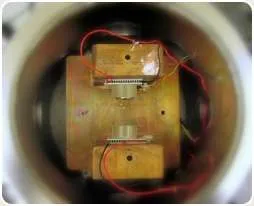
Another pyroelectric fusion device created by a separate team. This one uses two crystals to increase the accelerating field.
Credit
In summary, the pyroelectric Lithium Tantalate crystal is acting as a micro-particle-accelerator, firing deuterium ions into a fixed target to fuse two elements into new ones. This device works at room temperature, and no accelerating high voltage power supply is required. A crystal, a vacuum chamber, and a gas tube are all you technically need to fuse atoms (although, of course, actually building this is a bit more complicated).
Of course, these pyroelectric accelerators can be used for more than fusion. It is much simpler to use them to accelerate lighter electrons to high speeds, turning this accelerator into a decent X-Ray source when the electrons hit the target. This has actually been done by amateur experimenters, and I've even seen some reports that a pyroelectric fusion device was made by non-professionals as well.
Remember, these devices do not produce usable electric power. You will have to put in more electrical power into the device than you will get out in terms of fusion reactions heating up the target. The great challenge of nuclear fusion is building a device that can generate electricity from these reactions, which is what the great billion dollar facilities are working on. If such a device could be perfected, we could essentially have unlimited electrical power for the whole world, using deuterium from the oceans as fuel, with very few radioactive byproducts. But, that's probably a long way off. For now, all of us can get a little bit of nuclear fusion energy ourselves using a solar panel.
If you have any questions, comments, or corrections, please let me know! I hope you were able to learn something about pyroelectric fusion from this. Building a crude pyroelectric accelerator is something that I've wanted to do for awhile, but have been put off by the large cost of decent crystals. I should probably start searching Ebay again. My goal would not be nuclear fusion (as the gas system remains out of my skillset, for now) but an electron accelerator with X-Ray output seems perfectly doable. Hopefully I will be able to report back in some months time with a successful device.
Thanks for reading!
Images not credited are my own. You are welcome to use them with credit.
Sources for Additional Reading:
Nature: Observation of Nuclear Fusion driven by a Pyroelectric Crystal
Pyroelectric Fusion Wikipedia Entry
Pyroelectricity Wikipedia Entry
UCLA Crystallic Fusion
